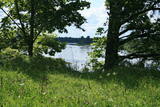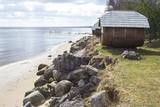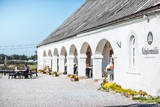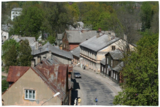| Nr | Nosaukums | Apraksts |
|---|---|---|
|
Savā ziņā unikāls un Baltijas valstīs vienīgais šāda veida 17. - 18. gs. mazpilsētas apbūves komplekss, kas izvietojies mazās Alekšupītes krastos. Dažviet upīte tek gar ēku sienām. Šī pilsētvide ar tiltiņiem radījusi apzīmējumu – „Latvijas Venēcija”. Interesantiem kultūras pieminekļiem bagātas ir Baznīcas, Liepājas, Kalna u.c. ielas. |
||
|
Neliela apdzīvota vieta Daugavas krastos starp Aizkraukli un Jaunjelgavu. Skrīveru apkaime saistās ar populārā latviešu rakstnieka A. Upīša gaitām un darbiem. Netālu no Skrīveriem meklējams arī vecākais Latvijas dendrārijs. Tā izveidi 1891. g. uzsācis Skrīveru muižas īpašnieks Maksimilians fon Siverss. Parka dendroloģiskajā klāstā ir ap 400 augu sugu, šķirņu un formu. Viens no lieliskākajiem Daugavas skatiem pavērsies no t.s. Kraukļu kalniem – stāva Daugavas labā pamatkrasta augšdaļas, kas ir sens pilskalns. |
||
|
Par Daugavpils dibināšanas gadu uzskata 1275. g.. Tas ir laiks, kad Livonijas ordeņa mestrs Ernests fon Ratceburgs Naujenes pilskalnā uzcēla Dinaburgas pili. Tā vairākkārt cieta lietuviešu un krievu iebrukumos, līdz 1577. g. pili nopostīja krievu karaspēks Ivana Bargā vadībā. Pēc šī notikuma Dinaburgu atjaunoja 17 km tālāk upes labajā krastā, kur tagad atrodas Daugavpils pilsēta. Laikā no 1810.-1833. g. tika uzbūvēts jauns cietoksnis. 1826. g. uzsāka tagadējā vēsturiskā centra apbūvi. 1. pasaules kara gados nozīmīgākos rūpniecības uzņēmumus kopā ar strādniekiem evakuēja uz Krieviju. Pirmās Latvijas Republikas laikā uzplauka Daugavpils kultūras dzīve. Lielākā pilsētas daļa tika nopostīta 2. Pasaules kara laikā - 1944. g. jūlijā. Mūsdienās Daugavpils ir otra lielākā Latvijas pilsēta un nozīmīgs Latgales vēsturiskā novada ekonomiskais centrs. Nesen uzsākta arī Eiropas mērogā unikālā Daugavpils cietokšņa atjaunošana. |
||
|
"Latgales sirds", kur 9. - 12. gs. pacēlās nocietināta latgaļu pils. 1285. g. Livonijas ordenis latgaļu pils vietā uzsāka mūra pils celtniecību. Pēc Livonijas sabrukuma (Rēzekne Polijas sastāvā) pilsēta nīkuļoja. Ekonomiskā dzīve Rēzeknē atjaunojās 18. gs. otrajā pusē. Pēc Pēterburgas-Varšavas šosejas (1836. g.) un dzelzceļa (1861. g.) izbūves Rēzekne kļuva par Pēterburgas atpūtnieku galamērķi. 2. pasaules kara laikā pilsētas apbūve būtiski cieta. Mūsdienās pilsēta ir nozīmīgs Latgales reģiona ekonomiskais un kultūras centrs. |
||
|
Latvijas vēsturei nozīmīga vieta, jo 12. - 13. gs. šeit atradās senās latgaļu zemes - Jersikas administratīvais un garīgais centrs ar Jersikas valdnieka Visvalža pili 18 m augstajā Daugavas krastā, kurā slējās varenais pilskalns. Pilskalna plakumu (100 x 75 m) apjoza valnis un no koka būvēta aizsardzības siena. Tā iekšpusē varēja iekļūt pa apsargātiem vārtiem, aiz kuriem bija izvietotas dzīvojamās un saimniecības ēkas un pat neliela baznīca. Pilskalnā ir veikti arheoloģiskie izrakumi, kuru laikā tika atsegtas guļbūves celtņu paliekas, kā arī atrastas daudzas 10. - 13. gs. senlietas, kas liecina par plašākiem tirdzniecības sakariem, t.sk. ar seno Krievzemi. 1209. g. bīskapa Alberta karaspēks ar viltu ieņem un izposta Jersikas pili un senpilsētu. Visvalža ģimeni saņem gūstā, tādēļ latgaļu valdnieks ir spiests kļūt par bīskapa vasali. Pilskalna teritorija ietilpst privātīpašumā, tādēļ tā apmeklējums ir jāsaskaņo ar īpašnieku. |
||
|
Sens lībiešu ciems, ar lībisko nosaukumu Mustanumm. Vēl 20. gs. vidū šeit dzīvoja lībieši. Melnsilā pie Baķupītes ietekas Rīgas jūras līcī, Landmaņu, Moricu un Otomeru dzimtas pārstāvji uzbūvēja trīs buriniekus. Melnsilā atrodas divas kultūrvēsturiskas vietas: senā kulta vieta - Baķu baznīckalns un jūras laupītāja Tromeļa pilskalns. (Avots: Rojas TIC) |
||
|
Aizputes pilsdrupas, akmens tilts pār Tebru, Jaunā pilsmuiža, ūdensdzirnavas un Sv. Jāņa luterāņu baznīca, kā arī 19. gs. beigās celtās koka ēkas starp Jāņa, Katoļu un Atmodas ielu veido neparastu pilsētbūvniecības kompleksu, kam piešķirts kultūras pieminekļa statuss. Staigājot pa vēsturisko centru, uzmanība jāpievērš ēku durvīm un to vērtnēm, logu ailēm, balkonu margām u.c. elementiem. |
||
|
Sens kursenieku zvejniekciems, kas vēstures avotos ir minēts 1429. g. Pirms 2. pasaules kara Jodkrante bija Eiropas mērogā iecienīts kūrorts, kas savas tradīcijas nav zaudējis arī mūsdienās. Par to liecina sakoptā vide un izcilā ainava (Kuršu kāpu ciemi Baltijas mērogā unikāli ar savu arhitektonisko vidi!) ar savdabīgajiem mazstāvu koka namiem, kuros izveidoti nelieli viesu un atpūtas nami. Jodkrantē var apmeklēt vairākus interesantus objektus – lielisku promenādi Kuršu jomas krastā, kas stiepjas visa ciema garumā ar akmens skulptūru brīvdabas ekspozīciju „Zeme un ūdens" (tapusi 1995. g.), Lietuvas mākslas muzeja izstāžu zāli, luterāņu baznīcu (1885. g.), vēja rādītāju galeriju un Raganu kalnu. |
||
|
Neliela pilsētiņa ceļā no Rīgas uz Bausku. Pilsētas vārds rakstiskajos avotos ir pieminēts 1492. g. Apskatāma luterāņu baznīca un bijušās muižas parks. |
||
|
Cesvaines vārds rakstiskajos avotos pirmoreiz minēts 1209. g. Pilsēta ikvienam Latvijas apceļotājam saistās ar baronu Vulfu dzimtu, kas 1815. g. iegādājās Cesvaines muižu. Cesvaines ekonomiskais uzplaukums pēc Pļaviņas-Gulbenes dzelzceļa izveides. Pilsēta cieta 2. Pasaules kara laikā. 2002. g. beigās Cesvaines pils skāra traģēdija – ugunsgrēks, kura laikā cieta lielākā pils daļa. Pēc liela sabiedrības, valsts un pašvaldības atbalsta Cesvaines pils „atgūstas" un joprojām saglabā Vidzemes un Latvijas mēroga tūrisma objekta statusu. |
||
|
Neliela apdzīvota vieta parka ziemeļrietumu daļā, kur var nokļūt tikai pa maziem lauku un meža ceļiem (arī ar tūristu autobusu). Te atrodas Lietuvā pazīstamākais Biškopības vēstures muzejs (Senovinės bitinkystės muziejus), kur var aplūkot dažāda veida stropus, bitenieku darbarīkus, koka skulptūras, kā arī iegādāties vietējo biškopju saražoto produkciju. Stripeiķos katru gadu 15. augustā notiek notiek biškopības sezonas noslēguma svētki. |
||
|
Liela meža masīva vidū gleznainās Būkas (Būka) upes krastos starp kokiem ieslēpies teiksmainais Vaišnoriškes ciems. Šis ir viens no skaistākajiem nacionālā parka etnogrāfiskajiem ciemiem. Vaišnoriške kā apdzīvota vieta sākusi veidoties 1756. g., kad šeit sena vēsturiska ceļa malā darbojies krogs. Pirmā viensēta ciematā ir zināma no 1830. g. Šodien redzamā apbūve ir tapusi g.k. 20. gs. sākumā. Ciems ir palicis cilvēku atmiņās ar liepu medu, jo meža velšu vākšana un biškopība bija viena no galvenajām šejieniešu nodarbēm. Tagad ciemā ir piecas sētas. No Vaišnoriškes var uzsākt laivu braucienu pa seklo un dzidro Būku. |
||
|
Atrodas Valmieras ziemeļdaļā. Valmiermuižas kungu māju (neobaroka stils) laikā no 1764. – 1771. g. cēla Šlēsvigas – Holšteinas – Zodenburgas – Bekas princis Pēteris Augusts Frīdrihs. Vēlākajos laikos tā pieder vairākiem citiem īpašniekiem. Pēc mūsdienās atrodamām liecībām varam spriest, ka muižas kungu māja 20. gs. sākumā bija vienstāvu ēka ar barokālu tornīti un divstāvu blakuskorpusu. Tā bija piemērota kā vasarnīca un medību izpriecu vieta. 1918. g. ēku nodedzina. Divus gadus vēlāk Valmiermuižā ierīko karagūstekņu nometni. Vēlāk kungu mājas piebūvi atjauno un izmanto kā pamatskolu. 1936. gadā ēkā izveido cietumu, kas 2. pasaules kara laikā kļūst par karagūstekņu ieslodzījuma vietu. Pēcāk ēka nodeg, un drupas tiek nojauktas. Līdz mūsdienām ir saglabājies Valmiermuižas tornis, kura telpu griestu gleznojumi tāpat kā parks ir kultūras piemineklis. Mūsdienās blakus vēsturiskajai vietai izveidota Valmiermuižas alusdarītava, un Valmiermuiža ir atguvusi otro elpu. |
||
|
Valdemārpils ir maza un klusa pilsētiņa, kas izvietojusies garā Sasmakas ezera krastā. Jau 17. gs. sākumā uz Sasmakas muižas zemes izveidojās amatnieku un tirgotāju miests. 19. gs. vidū Kurzemes pilsētās dzīvoja daudz ebreju tirgotāju un amatnieku, tādēļ Sasmaku tolaik dēvēja par ebreju galvaspilsētu. 1926. g. pilsētu pārdēvēja par Valdemārpili. Pilsētas vēsturiskais centrs ar 19. gs. apbūvi ir pilsētbūvniecības piemineklis. Valdemārpilī apskatāma luterāņu un pareizticīgo baznīcas, bij. Valdemārpils sinagoga, K. Valdemāram veltītais piemineklis, kā arī izcilā Valdemārpils Elku liepa. |
||
|
Maza apdzīvota vieta ar dažām viensētām uz pussalas (salos tulkojumā no lietuviešu valodas nozīmē „sala") starp vairākiem ezeriem. Salos II ir viens no sešiem Augštaitijas nacionālā parka etnogrāfiskajiem ciemiem. Ciems patiks tiem, kas meklē ļoti nomaļas vietas ar vecām guļbaļķu dzīvojamām un saimniecības ēkām. No Salos II pa sauszemes maršrutu var doties pārgājienā līdz Ladakalnim un Ginuču pilskalnam (sk. iepriekš). |
||
|
Kuldīgu pelnīti uzskata par skaistāko Latvijas viduslaiku mazpilsētu. Tās vietā jau pirms 13. gs. atradies senās kuršu zemes Bandavas centrs. 1242. g. Livonijas ordenis pie Ventas rumbas uzsāk mūra pils celtniecību. Pie pils izveidojas apdzīvota vieta, kas pirmā (1378. g.) Kurzemē iegūst pilsētas tiesības. Nozīmīga ir arī tās dalība Hanzas savienībā. Laikā no 1561. - 1795. g. Kuldīga ir Kurzemes hercogistes galvaspilsēta. Likumsakarīgi, 17. gs. pirmajā pusē tā piedzīvo strauju saimniecisko izaugsmi, kas beidzas līdz ar Ziemeļu kara un mēra epidēmijas sākumu. Kurzemnieku lepnums un lielāku industriālu objektu trūkums ir iemesls, kādēļ padomju laikā pilsētā neieplūda lielākas imigrantu masas, tādēļ Kuldīga šodien ir viena no latviskākajām Kurzemes pilsētām. Uz Kuldīgu ir vērts braukt un uzkavēties vairāk nekā vienu dienu, jo te darāmā netrūkst. Dabas mīļotāji var vērot lidojošās zivis, bet kultūrvēstures pētniekiem te paveras visnotaļ plašs darba lauks. |
||
|
Veidojās kā nu jau slēgtās Ignalinas AES (6 km attālumā) darbinieku pilsēta ar padomju laikiem izteiktām arhitektoniskām formām un monumentālismu. |
||
|
Pirmo reizi vēstures avotos 1253. g. šī vieta ir minēta kā kuršu apdzīvota apmetne. Laikā no 1637. – 1639. g. te uzcēla pirmās 19 kapelas – t.s. „Krusta ceļa stacijas", kas atgādināja Jeruzalemes Krusta ceļu. Kopš tā laika Žemaišu Kalvarija ir pazīstama kā nozīmīgs svētceļnieku galamērķis. Dažas no Krusta ceļa kapelām ir veidotas 17. – 18 gs., bet citas – 19. gs. Jāatceras, ka vēl pavisam nesen – Padomju laikos svētceļniekus nežēlīgi vajāja un represēja. Mūsdienās pilsētā ir izveidots 21 svētceļnieku „pieturas punkts". Te ik gadu (parasti no 2. – 12. jūlijam) notiek Žemaišu Kalvarijas katoļu draudzes svētki, kas pulcina daudz ļaužu no dažādām Eiropas valstīm. Iespaidīgā katoļu bazilika ir slavena ar Vissvētākās Jaunavas Marijas Katoļu Ģimeņu Karalienes gleznu, kas 17. gs. atvesta no Romas. Tai piedēvē brīnumdarītājas spējas. Interesants ir pilsētas ielu tīklojums, kas atgādina 9. – 13. gs. apdzīvotas vietas ielu plānojumu. Noteikti apskatāms iespaidīgais Žemaišu Kalvarijas pilskalns, kas slejas mazās Varduvas (Varduva) upītes krastā. |
||
|
Saldus vēstures dokumentos minēta jau 1253. g. Līdz 13. gs. te atradās senā kuršu pils Salden, kas arī attēlota pilsētas ģerbonī. Ap 1341. g. netālu no kuršu pilskalna Livonijas ordenis uzcēla pili, pie kuras izveidojās apdzīvota vieta. Savu uzplaukumu līdzīgi kā citas Kurzemes apdzīvotās vietas tā piedzīvoja hercoga Jēkaba valdīšanas laikā 1642. - 1682. g. Par Saldus dibināšanas gadu min 1856., kad sākās Ziemeļu karā nopostītās vietas atjaunošanas darbi. 2. pasaules kara beigās pie pilsētas norisinājās smagas kaujas, taču līdz pat 1945. g. 8. maijam pilsēta palika vācu armijas okupētajā Latvijas daļā. Mūsdienu Saldus piesaista ar saviem pasākumiem – pilsētas dienām, mūzikas festivālu "Saldus saule", kā arī dažādiem apskates objektiem, starp kuriem minama a/s „Druvas pārtika", kur var vērot saldējuma tapšanas procesu un Saldus pārtikas kombināts, kur var degustēt garšīgās konfektes „Gotiņa" un vērot ražošanas procesu. |
||
|
Pilsētā nebija lielu rūpniecības uzņēmumu, un tās iedzīvotāji
nodarbojās galvenokārt ar amatniecību, tirdzniecību un lauksaimniecību.
Ilūkste tika pilnībā nopostīta 1. pasaules kara laikā un smagi cieta arī
2. pasaules kara laikā. Šodien Ilūkste ir klusa pierobežas mazpilsēta, ko
ieskauj gleznains dabas apvidus. Apskates objekti: bijušā jezuītu klostera ēka
un Ilūkstes katoļu baznīca.
|
||





